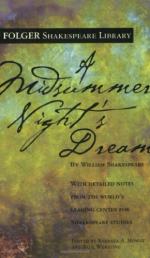|
This section contains 10,318 words (approx. 35 pages at 300 words per page) |

|
SOURCE: “Shakespeare, A Midsummer Night's Dream,” in Introduction to English Renaissance Comedy, Manchester University Press, 1999, pp. 46-69.
In the following essay, Leggatt surveys the plot, themes, and characters of A Midsummer Night's Dream, emphasizing the wide dispersal of power and authority in the play.
A Midsummer Night's Dream, like Friar Bacon and Friar Bungay, is a creation of the public theatre. It was performed by the Lord Chamberlain's Men, around 1595 or 1596, at the Theatre in the northern suburb of Shore-ditch. Many scholars have speculated that it was also performed at, and perhaps commissioned for, an aristocratic wedding; for some the speculation amounts to a certainty, and the only problem is to determine which wedding. In fact there is not a shred of evidence, internal or external, to support this theory; it is a self-perpetuating tradition with no basis in fact.1 When we think of the play's original performance...
|
This section contains 10,318 words (approx. 35 pages at 300 words per page) |

|


